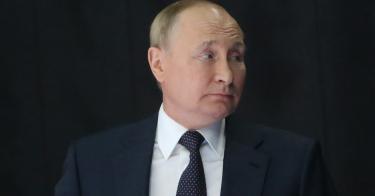When it comes to the threat of nuclear weapons, the U.S. typically focuses on our primary goal of preventing adversaries from using them. We do that with deterrence. Unfortunately, of late we’ve had to worry about preventing another tactic our adversaries are employing—nuclear coercion.
Deterrence dissuades opponents from taking a certain action; in other words, it uses the threat of force to maintain the status quo. By contrast, coercion uses the threat or show of force to compel an opponent to do something different.
In the last several months both Russia and China have been rattling their nuclear sabers. We’ll never know for certain whether it was these threats that prompted the Biden administration to take certain actions. But in several instances, it certainly seems that nuclear coercion was in play.
Let’s start with Russia.
>>> Biden Administration Cancels Routine Missile Test to Appease an Adversary … Again
Since the beginning of Russia’s invasion of Ukraine earlier this year Vladimir Putin and his subordinates have made constant nuclear threats against the West. For instance, when announcing the special military operation in Ukraine, Putin threatened “consequences you have never seen” to countries that interfere. More recently, Russian TV aired a warning that Russian nuclear missiles could strike the U.S. or UK.
The commander of U.S. Strategic Command, Adm. Charles Richard, has labeled this behavior both “implicit and explicit nuclear coercion.”
And it seems to be working. Shortly after Putin issued his first round of nuclear threats, the Biden administration postponed a routine, scheduled test of the Minuteman III long-range missile seeking to avoid raising further tensions with Russia. The administration has also restricted the Ukrainian military from using weaponry like the U.S. HIMARS system to strike into Russian territory, even if doing so would help the Ukrainian war effort. Again, the reason was to avoid provoking Russia.
We can’t know for sure if the administration would have made those decisions if the Russian nuclear threat were not so salient. But the question is worth asking, especially considering the United States’ disadvantage in nuclear weapons present in the European theater of conflict. While Russia has over 2,000 tactical nuclear weapons, which have less range and destructive power than intercontinental ballistic missiles, the U.S. only has a couple hundred. According to Adm. Richard, “[the Russians] are trying to exploit a perceived deterrence gap” here.
Then there’s China. Amid House Speaker Nancy Pelosi’s visit to Taiwan, China fired several nuclear-capable missiles into Taiwanese waters. In response, the Biden administration once again delayed a test of the Minuteman III long-range missile. These missile tests are critical for ensuring the reliability of the land-based element of the U.S. nuclear triad, and forgoing tests could add risk to the U.S. nuclear deterrent.
The U.S. introduced this risk as a direct result of China’s aggressive actions. That sounds like a win for President Xi Jinping.
Fortunately, that test was quickly rescheduled and executed. But future Chinese nuclear coercion efforts could have greater consequences. If China invades Taiwan, for instance, Xi could take a page from Putin’s playbook and threaten “consequences you have never seen” should the United States come to Taiwan’s defense.
This threat would not lack credibility. While China deploys hundreds of nuclear-capable missiles in the Indo-Pacific, the U.S. has none in that region. Succumbing to Chinese nuclear coercion in this instance and failing to help defend Taiwan would have massive ramifications for security, stability and proliferation in the region.
So how do we treat future Russian or Chinese attempts at nuclear coercion?
>>> Traditional Victory Over Russia Is Unlikely. Instead, Expect To Manage Competition for the Long Haul
First, the administration must accept that appeasing dictators will only encourage them to continue their bullying. Indeed, after Biden delayed the first Minuteman III test, Putin doubled-down by testing his new Sarmat missile capable of delivering nuclear-armed, hypersonic weapons to the U.S. homeland. And after delaying another Minuteman III test amid tensions with China, Xi expanded Chinese military exercises near Taiwan.
Moving forward, the U.S. needs to reject nuclear coercion by demonstrating the will to defend ourselves if necessary. Following through with routine missile tests to prove that U.S. nuclear missiles will work as intended is essential to this effort.
Second, the U.S. needs to develop the capabilities that would backstop this strong stance against aggression. We must field regional or tactical nuclear weapons in a way that would fill the perceived deterrence gap between the U.S. and both Russia and China.
Fortunately, the House of Representatives and both Senate defense committees have rejected the Biden administration’s decision to cancel the nuclear-armed sea-launched cruise missile, a weapon that would begin to fill these gaps.
While Russia and China have not employed a nuclear weapon, they have certainly used their growing forces to their advantage. To avoid being subject to nuclear coercion efforts in the future, the U.S. must demonstrate strength of its own.
This piece originally appeared in Defense Opinion



